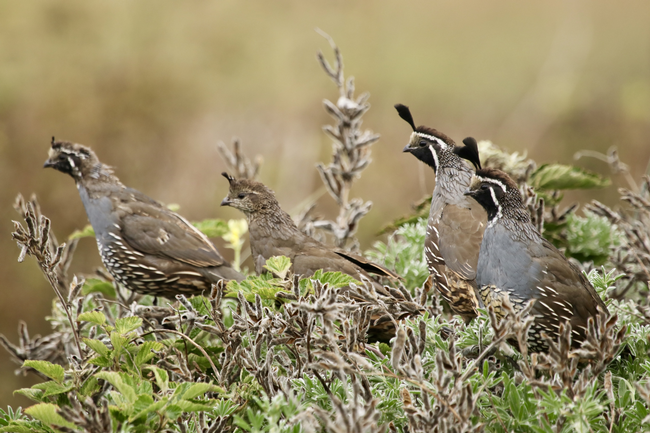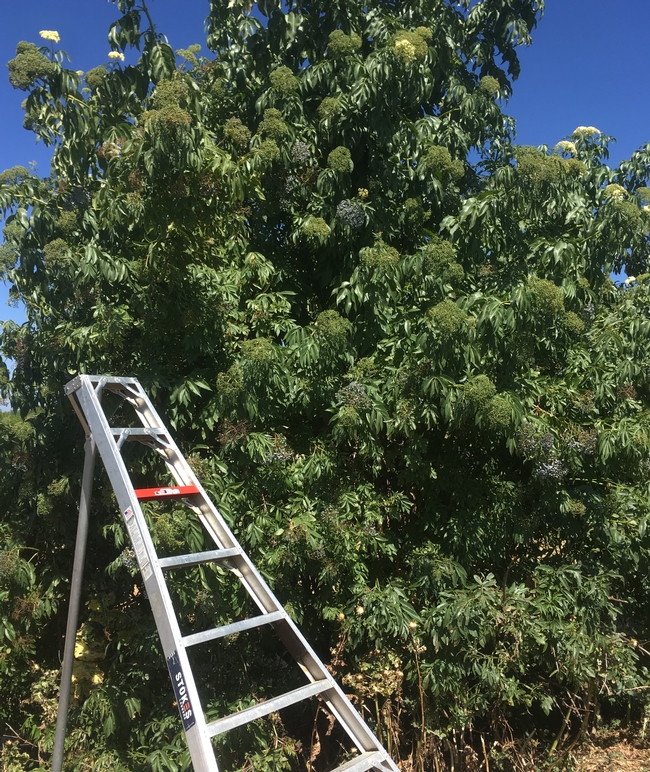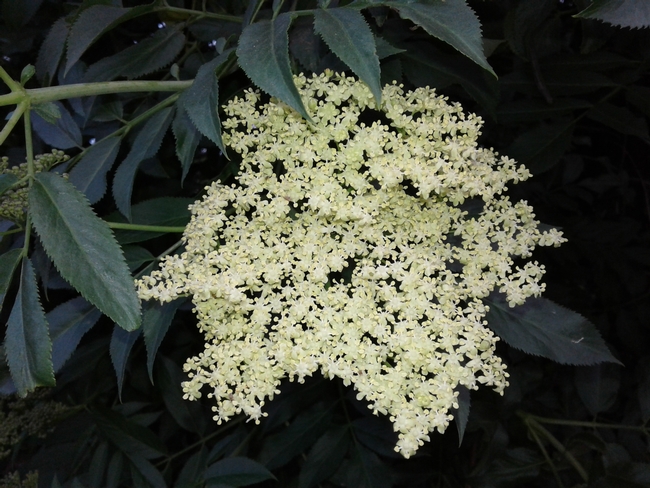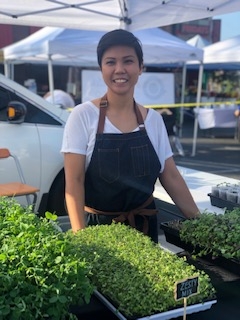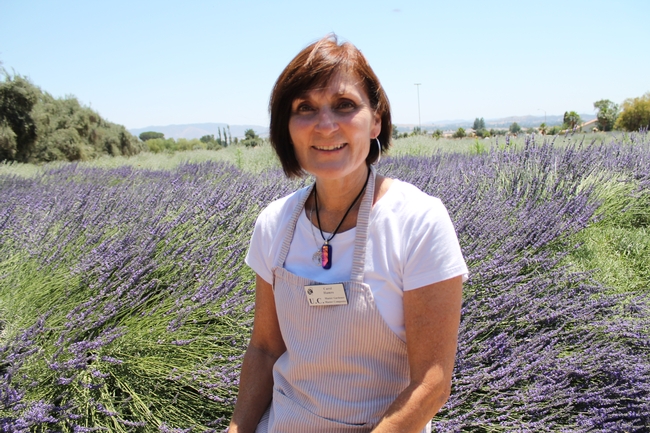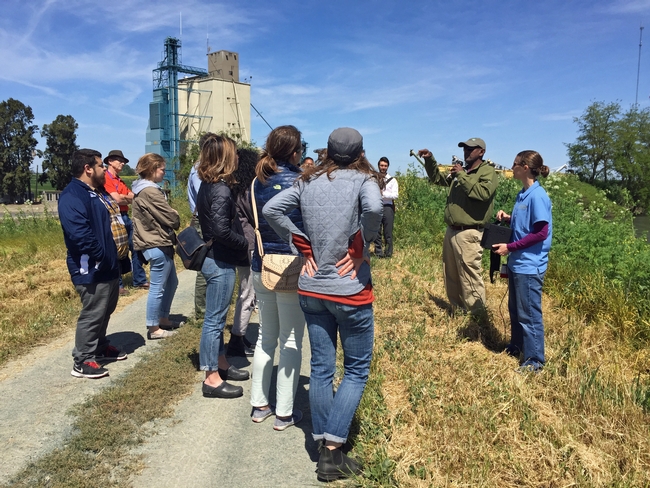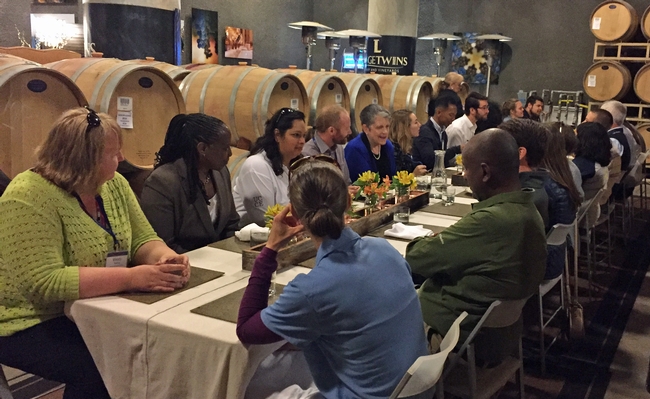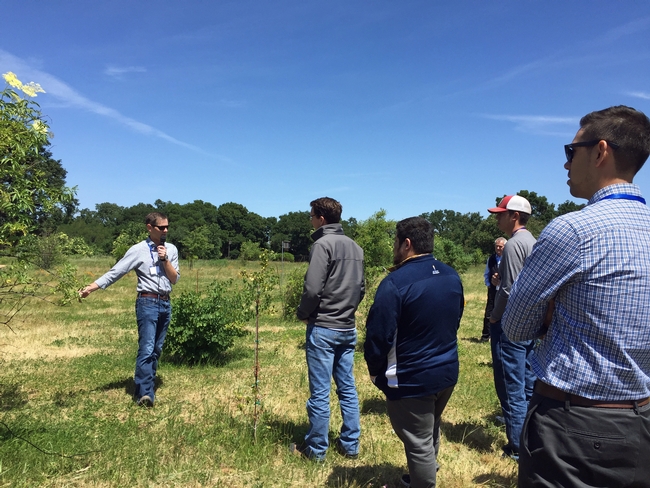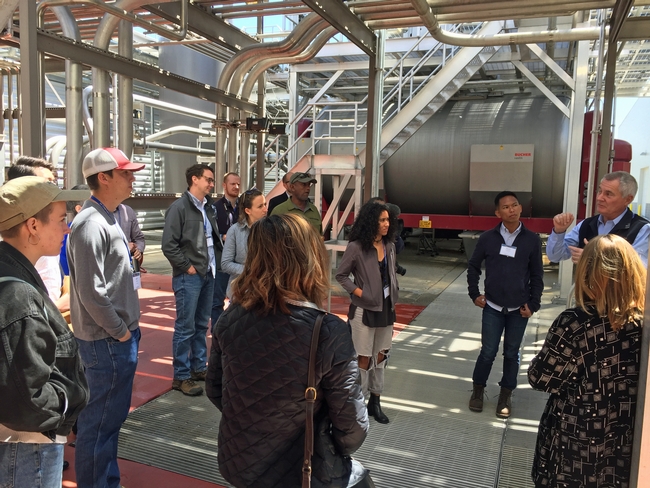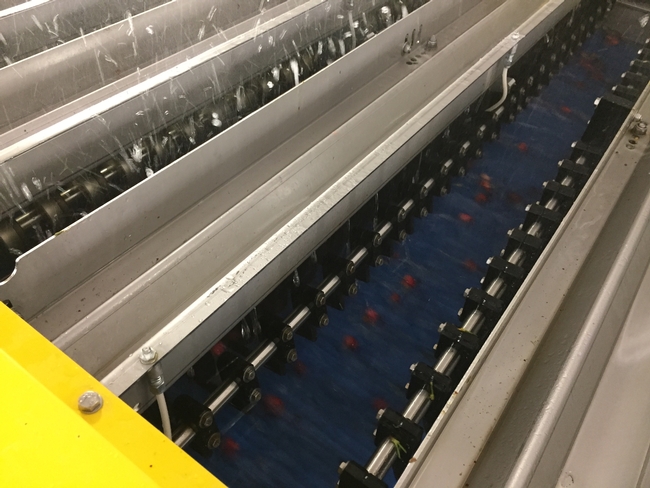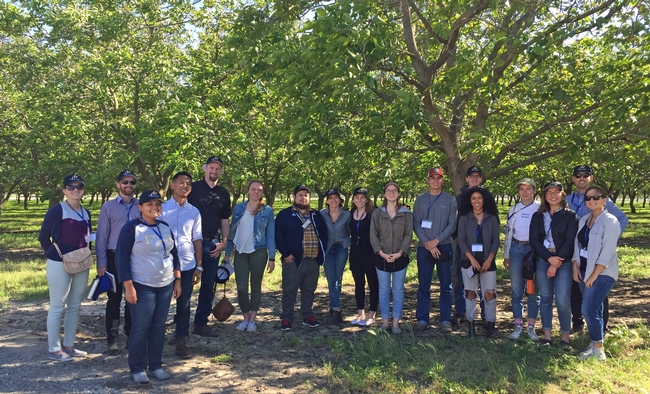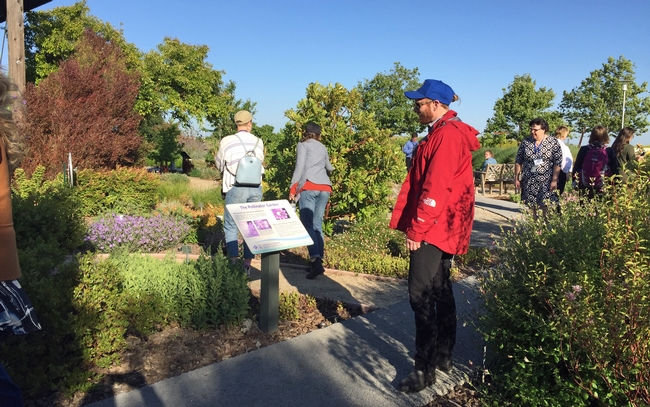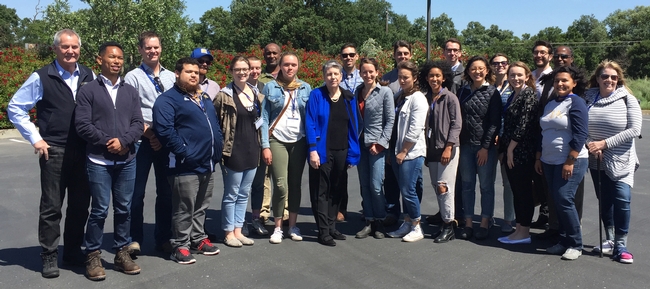Posts Tagged: farming
Bringing out the best in wild birds on farms
Natural habitat maximizes the benefits of birds for farmers, food safety and conservation
A supportive environment can bring out the best in an individual — even for a bird.
After an E.coli outbreak in 2006 devastated the spinach industry, farmers were pressured to remove natural habitat to keep wildlife — and the foodborne pathogens they can sometimes carry — from visiting crops. A study published today from the University of California, Davis, shows that farms with surrounding natural habitat experience the most benefits from birds, including less crop damage and lower food-safety risks.
The study, published in the Journal of Applied Ecology, was conducted at 21 strawberry fields along California's Central Coast. It found that birds were more likely to carry pathogens and eat berries without surrounding natural habitat.
The authors said a better understanding of the interplay of farming practices, the landscape, and the roles birds play in ecosystems can help growers make the most out of wild birds near their fields.
“Bird communities respond to changes in the landscape,” said lead author Elissa Olimpi, a postdoctoral scholar in the UC Davis Department of Wildlife, Fish and Conservation Biology at the time of the study. “As birds shift in response to management, so do the costs and benefits they provide.”
The single most important driver
The study looked at how different farming practices influenced the costs and benefits that wild birds provided on the strawberry farms. The scientists combined nearly 300 bird surveys and the molecular analyses of more than 1,000 fecal samples from 55 bird species to determine which birds ate pests, beneficial insects and crops, and carried foodborne pathogens.
They also ranked birds to see which were more likely to bring benefits or costs to farmlands. Barn swallows, for instance, got a “gold star” in the study, Olimpi said. Their mud nests are commonly seen clinging to the underside of barn eaves, from which they fly out to swoop over fields, foraging on insects.
But rather than resulting in a list of “good” and “bad” birds, the study found that most bird species brought both costs and benefits to farms, depending on how the landscape was managed.
The presence of natural habitat was the single most important driver differentiating a farm where wild birds brought more benefits than harm.
“Nature is messy, and birds are complex,” Olimpi said. “The best we can do is understand how to take advantage of the benefits while reducing the harms. Growers will tell you it's impossible to keep birds off your farm — you can't do that and don't want to from a conservation perspective. So how can we take advantage of the services birds provide?”
Win-wins for birds and farms
The study is one of several publications from UC Davis Professor Daniel Karp's lab highlighting the environmental, agricultural, and food safety impacts of conserving bird habitat around farms. A related study in 2020 found that farms with natural habitat attracted more insect-eating birds — and fewer strawberry-eating birds — so that farmers experience less berry damage on farms with more habitat nearby. Such habitats also bring greater numbers of bird species to the landscape.
“All together, these studies suggest that farming landscapes with natural habitat tend to be good for conservation, farmers, and public health,” said Karp.
Additional co-authors of this study include Karina Garcia and David Gonthier of University of Kentucky, Claire Kremen of UC Berkeley and the University of British Columbia, William E. Snyder of University of Georgia, and Erin Wilson-Rankin of UC Riverside.
The research was funded by the USDA and UC Davis Department of Wildlife, Fish and Conservation Biology.
New guide shows how elderberry activates hedgerows, ecologically and commercially
A farm-edge hedgerow can be more than a boundary or barrier. When it comprises blue elderberry, it can be a way to integrate biodiversity in an often-simplified agricultural landscape – and connect with a legacy of stewardship and use by California's Native peoples.
A new guide, published by UC Agriculture and Natural Resources, provides detailed instructions and advice for California farmers on growing, harvesting and marketing blue elderberry. It is available as a free download in the UC ANR catalog at https://anrcatalog.ucanr.edu/Details.aspx?itemNo=8709.
“It's the only publication of its kind, that we know of, that focuses on commercial production of a native species from within a hedgerow, which people normally think of as a conservation feature,” said Sonja Brodt, one of the publication's authors and associate director of UC ANR's Sustainable Agriculture Research and Education Program.
In addition to illustrating the plant's many ecological benefits, “Producing Blue Elderberry as a Hedgerow-Based Crop in California” highlights the economic viability of the products made from its flowers, berries and other components.
“Consumer interest in elderberry products is booming,” said Brodt, “and blue elderberry has the potential to meet local needs with a locally adapted species that is climate-resilient, and can be produced in a relatively low-input way that supports – rather than displaces – our native ecosystems.”
The guide incorporates the findings of a UC SAREP project exploring the farm management practices, nutritional content and market potential of elderberry products. And Brodt emphasized that this resource also draws upon the deep knowledge of Indigenous people, as well as best practices of growers such as Katie Fyhrie, formerly of The Cloverleaf Farm in Dixon and another author of the guide.
“We originally got inspiration to do this work from local farmers who are pioneering the use of blue elderberry harvested on their farms, and from Native Americans in California who have long stewarded and utilized blue elderberry for food and other cultural uses,” Brodt explained.
The other publication authors are Gwenael Engelskirchen, sustainable supply chain analyst for UC SAREP; and Katie Uhl, graduate student researcher; and Alyson Mitchell, professor in UC Davis' Department of Food Science and Technology.
Small-scale growers meet virtually to discuss organic agriculture
Over 150 current and prospective organic growers gleaned practical information shared by UC Agriculture and Natural Resources experts at the “Introduction to Small-Scale Organic Agriculture” workshop held virtually on Dec. 15, 2020. While most attendees were from inland San Bernardino, Riverside, Los Angeles and Orange counties, a handful were
from other continents, including growers from Bangladesh and Sri Lanka who stayed connected into the wee hours of their morning.“I attended this workshop and it was very helpful to hear different aspects of organic farming from experienced people,” one attendee from Sri Lanka said in an email.
UC Sustainable Agriculture Research and Education Program (SAREP) Director Gail Feenstra and Deputy Director Sonja Brodt kicked off the day with a presentation on program goals and resources. SAREP supports the goals of growers by developing more sustainable agricultural practices and effective regional food systems. They described a new online self-directed training program for organic specialty crop farmers in California and those in transition at https://ofrf.org/beginning-farmer-training-program. They also discussed marketing and business management.
Houston Wilson, director of UC ANR's new Organic Agriculture Institute, provided an overview of the program and pointed out that organic farming is expanding throughout California and includes more than 360 commodities. UC ANR will continue to take a lead role in developing and extending research and extension to this important sector, he said.
UC Cooperative Extension sustainable food systems advisor Rachel Surls discussed legal basics such as permits, licenses and regulations. UC Cooperative Extension organic agriculture specialist Joji Muramoto talked about the importance of soil health, a very popular and important topic. Other UC Cooperative Extension presenters covered nitrogen management (small farms advisor Margaret Lloyd), irrigation management (irrigation specialist Amir Haghverdi), integrated pest management (IPM advisor Cheryl Wilen), and plant diseases (plant pathology specialist Alex Putman).
“Thank you for the great workshop and resource links you provided for workshop materials and beyond! I have already downloaded and started to incorporate information from a few of the UC ANR pest management guidelines and legal and marketing links,” wrote an attendee from Chino. “Tips from peers are always great, too.”
During the afternoon portion of the workshop, five California organic farmers shared tips from their experiences. Carol Hamre (123 Farm, Cherry Valley) spoke about her trials and successes regarding vertebrate pest control and drip irrigation. Grace Legaspi (Tiny Leaf Micro Farm, Temescal Valley) talked about the art and science of growing microgreens. Lisa Wright (RD Flavorfull Farm, Riverside) discussed the importance of planting the right varieties in the right seasons. Arthur Levine (Huerta del Valle, Ontario) stressed the importance of collaboration and working synergistically as a team, and the importance of inclusiveness in all practices. Richard Zapien (‘R Farm, UC Riverside) shared inspiring stories and opportunities regarding the popular and successful UC Riverside community garden he manages.
“I am very glad to attend this workshop as a Bangladeshi,” wrote a grateful attendee from half way around the world. “Really, I have learned many things about organic farming in this workshop. I am working in the Tree nuts sector in Bangladesh but I have only cashew nuts plantation and processing factory…. I want to make an organic farm on 25 acres of land to cultivate vegetables, fruits, livestock, and fishing. Thanks again.”
Following the workshop, an extensive list of UCANR and external resources on topics covered during the workshop was provided to attendees https://ucanr.edu/sites/smallscalefarming/RESOURCES_/.
“I wanted to thank you for such a great webinar,” replied another Southern California participant. “I am a farm business advisor with the non-profit Kitchen Table Advisors and I learned a lot myself. Thank you for providing this list of resources. I look forward to the webinar recordings and slides, which I hope to be able to share with some of my farmer clients.”
The efforts of our co-sponsors also led to the overall success of the workshop. Inland Empire Resource Conservation District (IERCD) Manager Mandy Parkes, co-moderator, discussed district irrigation and soil testing resources and handed out gift certificates throughout the day. Evelyn Hurtado from IERCD volunteered to translate the workshop recordings into Spanish and Maggie O'Neill shared membership information and resources from the San Bernardino County Farm Bureau. Other co-sponsors included the Riverside County and Orange County Farm Bureaus. The California Certified Organic Foundation promoted the workshop and heightened awareness of UC ANR's programs and activities in the field of organic agriculture.
The PowerPoint presentations and recordings in English will be posted on the UCCE San Bernardino County website: https://ucanr.edu/sites/smallscalefarming/ by Feb. 15, 2021, and the Spanish translations later this winter. Next year, if conditions allow, actual farm visits will be included.
Delta farm tour gives UC students a broader view of food system
UC Global Food Initiative student fellows from University of California campuses throughout the state gathered for a springtime field trip in the Central Valley to learn more about the relationships between food, farming and the environment.
The day-long tour, hosted by UC Agriculture and Natural Resources, began at a farm that is maintained to support wildlife in the breezy Sacramento-San Joaquin River delta region. The GFI fellows also viewed a habitat restoration project at LangeTwins Winery then watched freshly harvested cherries being processed at Morada Produce's packing plant. They wrapped up the day with a tour of a demonstration garden and a discussion of nutrition education at the UC Cooperative Extension office in Stockton.
UC President Janet Napolitano, who, along with UC's 10 chancellors, launched the Global Food Initiative in 2014, met with the 17 fellows for lunch at LangeTwins Winery.
“We started the Global Food Initiative several years ago with the goal of creating a pathway to a sustainable, nutritious food future for the planet. A small, modest goal,” Napolitano said, adding that she is excited to learn about the fellows' projects.
The GFI fellows are working on projects that range from raising awareness about food production to analyzing the effects of climate change on pollination, and from efforts to make soils safe for growing food in urban areas to using food waste to fuel batteries.
UC Merced senior Ever Serna's GFI project is to educate his fellow college students about where food comes from, before it gets to the grocery store.
“The tour gave me a deeper understanding and appreciation about how food is developed and grown,” he said. “I think when I eat vegetables and fruits, I'm going to be more conscious of what I eat now.”
Reid Johnsen, a third-year Ph.D. student in agricultural and resource economics at UC Berkeley, Global Food Initiative fellow for UC ANR, and participant in the Graduate Students in Extension program, is working with UC Cooperative Extension in Sonoma County to study ranchers' preferences for different payment structures for conservation easement to compensate them for the ecosystem services provided by their land.
“To be able to see agriculture in action makes such a difference to me, to see the way the crops are produced and the variety that's out here,” said Johnsen. “The diversity of crops was not something I was aware of before coming on this trip.”
“I thought it was interesting to see a lot of different agricultural production systems,” said UC Santa Barbara senior and campus GFI ambassador Bryn Daniel, who works with student activists on student food access and housing security issues.
In addition to learning more about food production, the outing gave the fellows an opportunity to network with peers from other campuses.
“That's what I liked about today's meeting, just meeting everybody and getting these fantastic connections,” said Ryan Dowdy, a third-year Ph.D. student at UC Davis who is converting food waste into energy-producing microbial fuel cells.
“I think this program, and especially the fellowship, is really important for young scientists who dive into this really huge subject of global food,” said Claudia Avila, a graduate student at UC Riverside who studies trace metals in urban agricultural soils.
Best kept secret
In welcoming the UC GFI fellows, Glenda Humiston, UC vice president for agriculture and natural resources, said, “I have a feeling a lot of you aren't familiar with our division. As I travel around the state to different campuses, I keep being told that we're the best kept secret, which I personally do not think is a good thing."
She explained that agricultural research has been part of the University of California since the land-grant institution's beginning in 1868 in Oakland. UC ANR has researchers on the Berkeley, Davis and Riverside campuses and UC Cooperative Extension advisors in the county offices, she said, adding, “Here in California, our advisors have very robust research programs.”
Farms are wildlife habitat
Michelle Leinfelder-Miles, UC Cooperative Extension delta crops advisor, introduced Dawit Zeleke, associate director of conservation farms and ranches for The Nature Conservancy, who explained why he farms 9,200 acres of corn, triticale, potatoes, alfalfa and irrigated pasture to enhance foraging habitat for sandhill cranes and other wildlife on Staten Island. The Nature Conservancy partners with UC Cooperative Extension along with the U.S. Fish and Wildlife Service, the U.S. Geological Survey, California Department of Water Resources, Oregon State University, UC Merced and UC Davis to study the relationships between agriculture and natural resources.
The Pacific Flyway for migrating birds passes over the delta. “Eighty percent of waterfowl depend on agriculture for food,” Zeleke said. After wheat harvest, they flood the fields. “You should see it in September, October, November and December. Thousands of birds, ten thousand cranes use this place for habitat.”
Lodi region is zin-ful
En route to lunch, Paul Verdegaal, UC Cooperative Extension viticulture advisor for San Joaquin County, described the Lodi region's wine industry. There are about 750 growers, many of which are small family operations. While 10 to 15 acres used to be typical vineyard size, most have 100 acres to be sustainable and one family member works at an outside job.
“Agriculture is a tough job and there is no guaranteed income,” Verdegaal said.
About 40 percent of the zinfandel in California is grown in the Lodi region, but there are several wine grape varieties planted.
Pointing out the bus window to a vineyard interplanted with a crimson clover cover crop, Verdegaal said, “We do see interest in using as few chemicals as possible and using techniques of the integrated pest management program.”
After eating lunch at LangeTwins Winery in Acampo, the GFI fellows took a tour of the winery with the fourth- and fifth-generation owners, Randy Lange and Aaron Lange. The Langes are founding members of the Lodi Rules Program, which helps growers produce grapes and wines in a manner that is environmentally respectful, socially sensitive and economically sound. They pointed out an array of solar panels covering the grape press room that provide electricity. The Langes are planting native plants around the winery to reduce sedimentation, improve water quality and restore wildlife habitat along the Mokelumne River.
Bing is king of cherries
When the GFI fellows visited at the end of April, sweet cherry harvest had just begun in Bakersfield area orchards, and cherries were being packed and shipped in San Joaquin County.
“Hemmed in by rain to the north and heat to the south, cherry season is only eight to 10 weeks long,” said Joe Grant, emeritus UC Cooperative Extension farm advisor for San Joaquin County.
“While the Bing variety is still the mainstay of the California cherry industry because of its excellent eating and shipping quality,” said Grant, “acreage of other high quality and earlier-maturing varieties has increased in recent years to lengthen the harvest season. But Bing is still king.” Asked about the effects of climate change on cherries, Grant explained that warmer temperatures are reducing the number of winter chilling hours, which cherries need.
The fellows saw the hand-picked fruit being processed for packing at Morada Produce, a family farm in Linden that also grows walnuts, peppers and onions.
“Keeping produce cold is key to maintaining quality,” said Scott Brown, Morada's production manager, as the fellows watched fresh, cold water rain down onto the freshly picked sweet cherries. The leaves and stems floating to the top were removed as the red clusters glided in the water to the cluster cutter, which gently separated the clusters into individual cherries. Gently conveyed through the plant in flowing water, the cherries were sorted by size and quality at the highly mechanized facility. Air ejectors spit out rejected fruit, so only 70 percent makes it into a packed box.
“Fruit picked on Monday is packed Tuesday, then shipped to Korea, Japan, Australia and other export markets to be eaten by Friday,” Brown said.
The fellows were fascinated to see the steps taken to ensure high-quality cherries are cooled, sorted and packaged for shipping to stores and consumers.
“It was just so much more complicated than I knew,” said Jess Gambel, a third-year Ph.D. student at UC San Diego who is studying the effects of climate change on bee pollination in squash plants.
Sustainable gardening
The tour wrapped up at the UC Cooperative Extension office in Stockton, with a discussion about how UC CalFresh and the Expanded Food and Nutrition Education Program help low-income Californians attain adequate nutrition and food security, followed by a tour of the demonstration garden maintained by the UC Master Gardener Program volunteers.
“There are more pollutants in urban runoff than in ag runoff,” said Karrie Reid, UC Cooperative Extension landscape horticulture advisor in San Joaquin County. Reid described how she and the UC Master Gardeners work with home and community gardeners to reduce pesticide and water use, and noted that a Water Use Classification of Landscape Species plant list, based on UC research, is available to help gardeners choose landscape plants.
“As a soil scientist, I really appreciated the recurring emphasis on soils as the foundation for agriculture,” said a fourth-year Ph.D. student at UC Berkeley and GFI fellow with Lawrence Berkeley National Laboratory. “From talking with The Nature Conservancy farm operator about how they were conserving carbon in those soils and doing wetlands management to hearing about special properties of the sandy loam soil in this part of the county, and talking with the Master Gardener folks about soil contamination issues.”
This is the third class of GFI student fellows. The undergraduate and graduate student fellows, representing all 10 UC campuses plus UC Agriculture and Natural Resources and Lawrence Berkeley National Laboratory, have helped further UC's Global Food Initiative efforts to sustainably and nutritiously feed the world's growing population by working on food-related projects and raising awareness of this critical issue.
Videos explore the future of farming
Pop quiz: About 7 billion people live on earth today, and that number is expected to hit 9 billion by 2050. That’s a lot of mouths to feed. What’s the best way to reform our global food production to meet the rising demand?
- Invest in technology, plant breeding, soil science and seed genetics to make our finite farm land more productive.
- Increase sustainability, so farm land can remain productive in the future.
- Encourage more people to get into farming.
- Help farmers manage climate change, water supply and pest control.
- All of the above and a whole lot more.
Yep, the answer is e. All of the above and a whole lot more. Many of the challenges and solutions are explored in a new video series on YouTube called "9 Billion Mouths to Feed: The Future of Farming."
Produced by UC Davis in cooperation with University of California’s "UCTV," the four 10-minute videos provide an excellent overview of modern problems facing our food supply.
"There’s a growing population and we’re going to need to produce more food in a sustainable way to feed them all," says Genevieve Lipari, a UC Davis student featured in the videos. “And it’s not just agriculture, it’s food access, health, nutrition and so much more.”
Indeed, agriculture isn’t just about sowing the land. The videos bring that fact to life, showing the work California farmers and UC Davis students and researchers are doing to ensure an abundant food supply that’s healthy, tasty and safe.
The videos are perfect for students young and old, and anyone interested in finding innovative ways to feed the world without depleting our limited resources.
We might not have all the answers on how to feed a growing population, but the videos shine light on some of the many farmers, scientists and students working together to try to meet that growing need.
You can watch “9 Billion Mouths to Feed” at www.uctv.tv/farming


